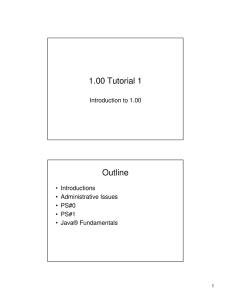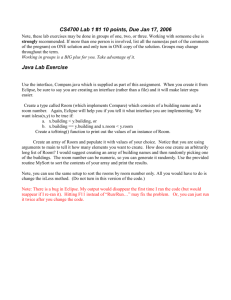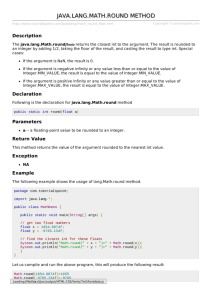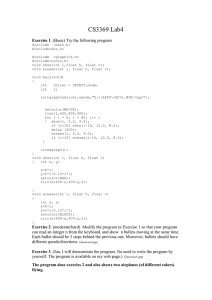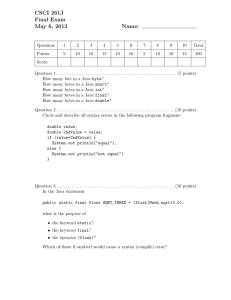Document 11592013
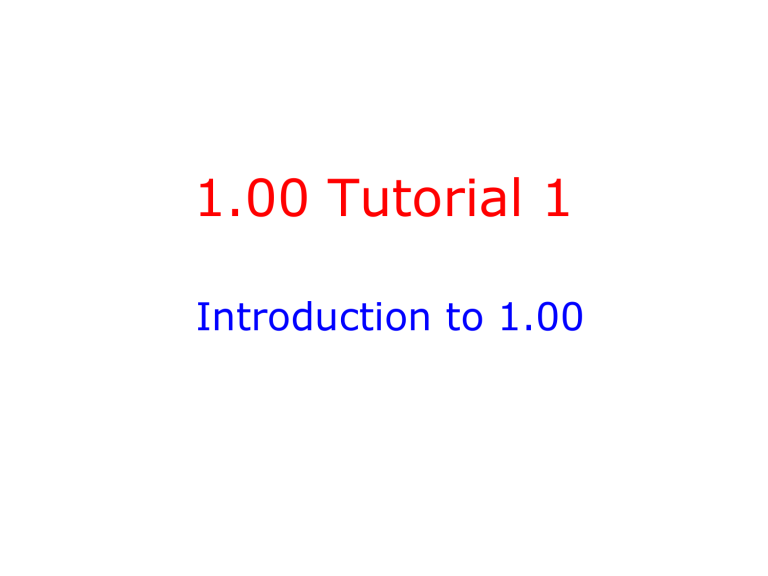
1.00 Tutorial 1
Introduction to 1.00
Outline
• Introductions
• Administrative Stuff
• PS 0
• Java Basics
• Eclipse practice
• PS1 discussion
Administrative stuff (1)
Top five reasons why you should attend tutorials:
• You get the opportunity for individualized instruction and interactive discussion of questions and concepts.
• You get to write some code in a cozy atmosphere
• You get to speak and ask questions (don’t be shy!)
• You get to review some key points from lecture, to discuss problem sets, and to practice for quizzes and final exam
• Mandatory (if you want full credit– 6%)
– Grade based on participation
Administrative stuff (
2
)
Getting help
THE GOLDEN RULES:
1Start EARLY , we mean REALLY early .
2Do not start a problem set without making sure that you fully understand the lecture concepts. Homework is just an application of key lecture ideas.
3- The debugger is there for a reason. Use it! It can be really fun, and would spare you hours of hassle.
• Feel free to come with general questions about Java, software, lectures, tutorials or homework. However, we will NOT :
- Dedicate the entire afternoon to you. There are 200 people taking the class, sorry!
- Read the problem set for you. If you haven’t attempted it before, you will be asked to leave (we look sweet, but we can be rude at times)
- Write any lines of code for you. This is what tutorials and active learning sessions are for.
- Answer questions of the type: “I have the following 200 lines of code. Why isn’t my program running correctly?”. We are neither debuggers nor prophets.
Administrative stuff (
3
)
Laptop Problems/etc
• Use a power cable when you can
• Always back up your work, either using
CDR’s or USB Flash drives
• Please remember to put a comment in your code with your name, email id, TA &
Section Name
PS 0
• Academic Honesty
– It’s less work to do the problem sets than to cheat without getting caught.
• Introduction to Eclipse
– Start Eclipse now!
• Submitting homework and printing
– Ask us before/after lecture or go to office hours this week if you’re having problems
Java Basics (1)
• Declaring variables
– initial value required? what about type?
-- a variable is simply a memory location that stores a value.
• Assigning a value vs. testing a value
– compiler will catch this, but know the difference (= v/s ==)
• Declaring floats and longs (F / L)
• Representing booleans
– use true/false, not 0/1
• Naming conventions
– Java is case-sensitive!
– classes and filenames: always Capitalize
– variable names: int runningSpeed=55;
– must begin with letter, underscore, or $
– final variables: final double PI = 3.1416;
Java Basics (2) : fundamental types type boolean byte char short int long float double bits
1
8
16
16
32
64
32
64
Java Basics (3): examples
int studentCount = 91; char firstLetter = 'a'; float weight = 180.6
F ; double area = Math.PI * 5.0 * 5.0; boolean enjoy100 = true; boolean xGreaterThanY = (x > y); long theNumberOne = 1 L ; double googol = 1E100; //10 100
– Make sure you don’t use Java keywords ( do , while , import …) as variable names!
Java Basics (4): type conversion
• Implicit (automatic) conversion is called promotion: int promoted to double double x = 3.1415 + 2;
• Explicit conversion is called casting int myAge =
(int)(Math.PI*10.0+4.0); expression cast to int this expression is a double (very accurate)
Java Basics (5): promotion
Data Type double float long
Allowed Promotions
None double float,double int char long,float,double int,long,float,double short int, long,float,double byte short,int,long,float,double
Eclipse practice (1)
Setup
• On your hard drive, create a folder that will hold all your Java files throughout the semester.
• Start Eclipse by double-clicking on its icon
• Create a new project named Tutorial1 or
Tut1 . Project names have nothing to do with actual folder names.
• Under this project, create a new class called GettingInput.
It should have a main
() method.
Eclipse practice (2)
Variables, control structures, debugger
• Declare a long and set it equal to 1000
• Declare a float and set it equal to 2.33
• Write a for loop that starts from 1 and increments the counter i by 2 in each iteration.
Print the value of the counter at every iteration.
• Use the debugger to trace the values of all variables in your program. Don’t forget to use a breakpoint.
• Replace the for loop by an equivalent while loop
Eclipse practice (3)
JOptionPane
• Ask the user for temperature in
Fahrenheit using a JOptionPane
• import javax.swing.*;
• Store the input in a variable tempF
• Convert it to Celsius and print it out using System.out.println()
• tempC = (tempF-32)*5/9
θ ) mg*sin(
θ a mg
θ
Problem Set 1
µ *mg*cos(
θ )
Force equilibrium along the plane ma = mg*sin( θ )µ *m*gcos( θ ) mg*cos( θ )
Problem Set Practice
• Ask the user to enter two masses m1 and m2
• If m1 is greater than m2 then swap their values
